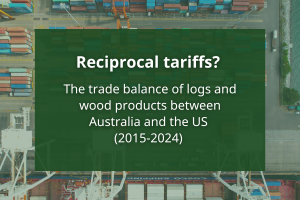Emphasising the pressures in the Australian market, sales of sawn softwood were down 5% year-ending July 2015, compared with the year-ending July 2014. Over the same period, sawn softwood imports rose a substantial 26.6%. With exports negligible, there can be no doubt that imports are replacing domestic production, despite the depreciation of the Australian Dollar over the last year.
As the chart below shows, sawn softwood sales totaled 2,603,716 m3 for the year-ending July 2015 and are showing a decided downturn, being well off their peak.

To go straight to the dashboard and take a closer look at the data, click here.
In July 2015, sales totaled 228,849 m3, down 13.9% compared with July 2014, when sales totaled 260,745 m3. Every month of 2015 has seen sawn softwood sales lower than the same month a year earlier.
At the same time, imports have grown very strongly over the last year, despite a sharp correction in May 2015, as the chart below shows.

To go straight to the dashboard and take a closer look at the data, click here.
For the year ending July 2015, imports rose to a new record of 736,684 m3. This large increase was driven by a more than doubling of imports of Dressed Sawn Softwood, which rose more than 110% to 267,677 m3. As the chart below shows, the rise in imports of this grade is nothing short of spectacular.

To go straight to the dashboard and take a closer look at the data, click here.
The countries involved in the dramatically increased trade of Dressed Sawn Softwood are nearly all European. Long the major importer, Estonia has again dominated imports in the year-ending July 2015, as the table below shows.
Dressed Sawn Softwood Imports by Country: YE Jul ’15 (m3 & %)
| Country | Volume YE July 2015 | % Change on PCP |
| Austria | 56,357 | +88.0 |
| Estonia | 61,649 | +82.4 |
| Finland | 40,177 | +117.4 |
| Germany | 3,733 | +20.1 |
| Lithuania | 35,072 | +48.3 |
| Sweden | 59,641 | +591.7 |
| USA | 3,340 | -40.2 |
| Other | 7,708 | +89.7 |
Source: ABARES/ABS
The table shows massive import increases, except for the USA, which experienced a decline over the year. Imports from the USA have succumbed under the pressure of a depreciated Australian Dollar, which has made the US product more expensive.
Imports denominated in Euro have not been impacted the same way, as the data shows. This is because the Australian Dollar depreciated by just 3.9% over the year-ending July 2015, compared with the 21.5% depreciation against the US Dollar.
But that doesn’t entirely explain the European sawn softwood imports, which were, on average, 8.9% higher priced than the average the year before.
The challenge, amidst this somewhat conflicting data, is deciphering what exactly has driven a rise in imports and import prices, while domestic dressed sawn softwood sales are declining.



